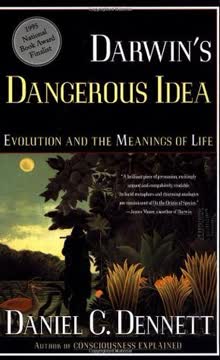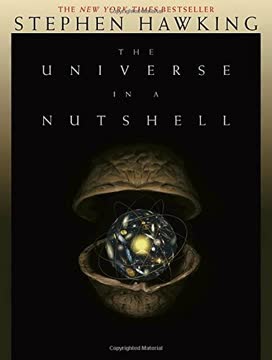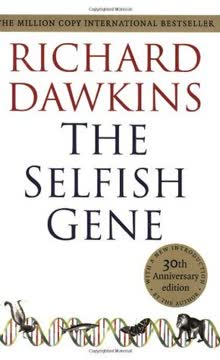Key Takeaways
1. Natural selection is the blind watchmaker, creating complex designs without purpose
Natural selection is the blind watchmaker, blind because it does not see ahead, does not plan consequences, has no purpose in view.
Complexity without design. The apparent design in nature, from the intricate workings of the eye to the aerodynamic shape of a bird's wing, is not the result of a conscious creator but of natural selection. This process, acting over millions of years, can produce incredibly complex and well-adapted organisms without any foresight or planning.
Natural selection works through:
- Random genetic mutations
- Differential survival and reproduction of organisms
- Inheritance of beneficial traits
Illusion of purpose. While the results of natural selection may appear purposeful, this is an illusion. The process itself is entirely mechanistic and driven by immediate survival and reproductive advantages, not long-term goals. This concept challenges our intuitive understanding of design and purpose in nature, requiring a shift in perspective to fully grasp the power of evolutionary processes.
2. Cumulative selection is the key to understanding evolutionary change
Cumulative selection, once it has begun, seems to have almost unlimited power.
Power of small changes. Cumulative selection is the process by which small, incremental changes accumulate over time to produce significant results. This concept is crucial for understanding how complex adaptations can evolve through a series of manageable steps, rather than arising all at once.
Key aspects of cumulative selection:
- Each step provides a small advantage
- Beneficial changes are preserved and built upon
- The process can lead to dramatic results over time
Analogy of the combination lock. Dawkins uses the analogy of a combination lock to illustrate the difference between single-step selection (pure chance) and cumulative selection. While the odds of randomly guessing a complex combination are astronomically low, a process that provides feedback on each digit would make solving the lock much more feasible. Similarly, natural selection provides "feedback" through differential survival and reproduction, allowing complex adaptations to evolve gradually.
3. DNA is the digital information technology of life
There is enough storage capacity in a single human cell to store the Encyclopaedia Britannica, all 30 volumes of it, three or four times over.
Information storage in life. DNA is essentially a digital code, storing vast amounts of information in a remarkably compact form. This information technology is the basis for all life, containing the instructions for building and operating living organisms.
Key features of DNA as information:
- Uses four "letters" (A, T, C, G) to encode information
- Information is copied and passed on to offspring
- Mutations can introduce new variations
Implications of DNA's information capacity. The immense storage capacity of DNA highlights the potential for complexity in living organisms. It also underscores the importance of information transfer and processing in biology, drawing parallels between life and human-designed information technologies.
4. Genes cooperate within species but compete between species in arms races
Genes are selected, not for their intrinsic qualities, but by virtue of their interactions with their environments.
Gene interactions. Within a species, genes often cooperate to produce beneficial traits. However, between species, genes can engage in evolutionary arms races, constantly adapting to counter the adaptations of other species.
Examples of gene cooperation:
- Multiple genes working together to produce complex traits
- Genes for different parts of an organ (e.g., eye) evolving in concert
Examples of evolutionary arms races:
- Predator-prey adaptations (e.g., faster cheetahs vs. faster gazelles)
- Plant defenses vs. herbivore adaptations
Importance of context. This concept emphasizes the importance of considering genes in their environmental context, including the presence of other genes and competing organisms. It helps explain both the harmony within organisms and the ongoing evolutionary struggles between species.
5. Sexual selection can lead to explosive evolutionary changes
Plumage development in the male, and sexual preference for such developments in the female, must thus advance together, and so long as the process is unchecked by severe counterselection, will advance with ever-increasing speed.
Runaway selection. Sexual selection, particularly when driven by female choice, can lead to rapid and extreme evolutionary changes. This process can explain the development of extravagant traits that seem to defy utilitarian explanation, such as the peacock's tail.
Mechanisms of sexual selection:
- Female preference for certain male traits
- Competition between males for mates
- Genetic linkage between trait and preference genes
Positive feedback loop. The key to understanding explosive sexual selection is the concept of a positive feedback loop. As females prefer a certain trait, they are also selecting for the genes that make their daughters prefer that trait. This can lead to a self-reinforcing cycle of ever more extreme trait development, limited only by countervailing survival pressures.
6. Evolutionary change is usually gradual, not punctuated
It is entirely possible that our backwater of a planet is literally the only one that has ever borne life.
Gradualism vs. punctuationism. Dawkins argues against the idea that evolution proceeds primarily through rapid bursts of change followed by long periods of stasis (punctuated equilibrium). Instead, he advocates for a more gradual view of evolutionary change, where small modifications accumulate over time.
Arguments for gradualism:
- Most adaptations require many small steps to evolve
- The fossil record often appears punctuated due to incompleteness
- Gradual change can appear rapid on geological timescales
Importance of timescale. Understanding the vast timescales involved in evolution is crucial for appreciating the power of gradual change. What might appear as a sudden jump in the fossil record could represent millions of years of gradual modification.
7. Cultural evolution shares similarities with biological evolution
Memes can propagate themselves from brain to brain, from brain to book, from book to brain, from brain to computer, from computer to computer.
Memes as cultural replicators. Dawkins introduces the concept of memes as units of cultural information that evolve in ways analogous to genes. This idea provides a framework for understanding cultural change through an evolutionary lens.
Similarities between cultural and biological evolution:
- Replication (ideas are copied from person to person)
- Variation (ideas change as they are transmitted)
- Selection (some ideas spread more successfully than others)
Implications of memetic evolution. The concept of memes offers insights into the spread of ideas, technologies, and cultural practices. It suggests that cultural evolution, like biological evolution, can produce complex and well-adapted results without conscious design. However, the analogy between genes and memes is not perfect, and the concept remains controversial among some scholars.
Last updated:
FAQ
What's The Blind Watchmaker about?
- Explaining complexity in biology: Richard Dawkins explores how complex biological structures can arise through natural processes, specifically through natural selection, without the need for a conscious designer.
- Natural selection as a mechanism: The book presents natural selection as a "blind watchmaker" that operates without foresight, gradually leading to the evolution of complex organisms from simpler ancestors.
- Countering creationist arguments: Dawkins refutes creationist views by illustrating how evolutionary theory provides a robust explanation for the diversity of life, using examples like the eye and echolocation in bats.
Why should I read The Blind Watchmaker?
- Clear and engaging writing: Dawkins presents complex scientific ideas in an accessible manner, making it suitable for both lay readers and those with a scientific background.
- Defending Darwinism: The book offers a vigorous defense of Darwinian evolution, equipping readers with the knowledge to engage in discussions about evolution and creationism.
- Inspiring wonder about nature: Dawkins conveys a sense of awe regarding the complexity of life, encouraging readers to appreciate the beauty of biological systems.
What are the key takeaways of The Blind Watchmaker?
- Natural selection is nonrandom: While mutations may occur randomly, natural selection systematically favors traits that enhance survival and reproduction.
- Complexity arises from simplicity: Dawkins illustrates how complex structures evolve from simple beginnings through small, cumulative changes, essential for understanding life's evolution.
- Importance of intermediate forms: Every complex organ can be traced back through intermediate forms that provided survival advantages, supporting the plausibility of evolutionary theory.
What are the best quotes from The Blind Watchmaker and what do they mean?
- "The only watchmaker in nature is the blind forces of physics.": This quote highlights that natural selection, not a conscious designer, is responsible for life's complexity.
- "If it can be said to play the role of watchmaker in nature, it is the blind watchmaker.": It emphasizes that natural selection shapes life without foresight or intention.
- "Evolution — The Greatest Show on Earth — The Only Game in Town!": Reflects Dawkins' enthusiasm for evolutionary theory as the most compelling explanation for life's diversity.
How does Dawkins explain the concept of cumulative selection in The Blind Watchmaker?
- Cumulative vs. single-step selection: Dawkins distinguishes between random single-step selection and cumulative selection, where each change builds on previous successes.
- Example of the monkey typing: He uses this analogy to illustrate the improbability of achieving complex phrases without cumulative selection, highlighting the power of gradual improvements.
- Real-world implications: Cumulative selection is crucial for understanding how complex traits evolve, showing that small, beneficial changes can accumulate over time.
How does Dawkins address the argument from design in The Blind Watchmaker?
- Critique of Paley's analogy: Dawkins critiques the argument that complexity implies a designer, explaining that natural selection can account for the appearance of design.
- Blind forces of nature: He emphasizes that the "blind forces of physics" are responsible for the complexity in living organisms, challenging the need for a conscious designer.
- Natural selection as a mechanism: Dawkins presents natural selection as a robust mechanism that can explain intricate designs found in nature.
What is the concept of "selfish genes" in The Blind Watchmaker?
- Genes as units of selection: Dawkins introduces the idea that genes are the primary units of natural selection, acting in their own interest to ensure survival and replication.
- Influence on behavior: The "selfish gene" concept suggests that behaviors can be understood as strategies to maximize gene replication, even if they appear altruistic.
- Cultural implications: This idea extends beyond biology, influencing discussions in sociology and psychology about how behaviors are shaped by genetic imperatives.
How does Dawkins explain the relationship between evolution and complexity in The Blind Watchmaker?
- Gradual accumulation of changes: Complexity arises through the gradual accumulation of small, beneficial changes over time, rather than sudden leaps.
- Role of natural selection: Natural selection favors traits that enhance survival and reproduction, leading to increasingly complex adaptations.
- Digital information in DNA: The digital nature of genetic information allows for precise changes that can lead to complex traits, akin to how computer programs evolve.
What is the significance of "arms races" in evolution as discussed in The Blind Watchmaker?
- Predator-prey dynamics: Dawkins uses arms races to illustrate how evolutionary pressures between predators and prey lead to adaptations enhancing survival.
- Positive feedback mechanism: As one side evolves better defenses or strategies, the other must adapt, creating a cycle of continuous improvement.
- Examples in nature: The book provides examples of arms races, highlighting their role in contributing to life's complexity and diversity.
How does Dawkins use the analogy of the "blind watchmaker" throughout The Blind Watchmaker?
- Metaphor for evolution: The "blind watchmaker" serves as a metaphor for natural selection, emphasizing that evolution is an unguided process.
- Contrast with intelligent design: Dawkins contrasts evolutionary processes with intelligent design, arguing that natural selection explains complexity without divine intervention.
- Illustrating complexity: The analogy conveys that while evolutionary outcomes may appear designed, they result from random mutations filtered through natural selection.
What is the "Red Queen effect" mentioned in The Blind Watchmaker?
- Continuous evolutionary pressure: The Red Queen effect describes the need for species to constantly adapt to maintain their status amid evolving competitors.
- Metaphor from Lewis Carroll: Derived from Through the Looking Glass, it illustrates the relentless nature of evolutionary pressures.
- Implications for evolution: This concept highlights the dynamic nature of evolution, where species are in a constant race to keep up with environmental and competitive changes.
How does Dawkins address the concept of "macromutation" in The Blind Watchmaker?
- Definition of macromutation: Dawkins defines macromutations as large-scale mutations that could lead to significant evolutionary changes in a single generation.
- Critique of macromutation theories: He argues against their significance, stating that most beneficial changes are small and gradual, with large mutations often being harmful.
- Examples of macromutations: Dawkins references specific examples to demonstrate that while macromutations can occur, they rarely contribute positively to evolution.
Review Summary
The Blind Watchmaker receives mostly positive reviews for its clear explanation of evolutionary theory and natural selection. Readers appreciate Dawkins' articulate writing style and logical arguments against creationism. Many find the book enlightening and praise its ability to convey complex scientific concepts to a general audience. Some criticize certain sections as dry or outdated. Overall, reviewers consider it an important work for understanding evolution, though some religious readers remain unconvinced by Dawkins' atheistic conclusions.
Similar Books










Download PDF
Download EPUB
.epub digital book format is ideal for reading ebooks on phones, tablets, and e-readers.













